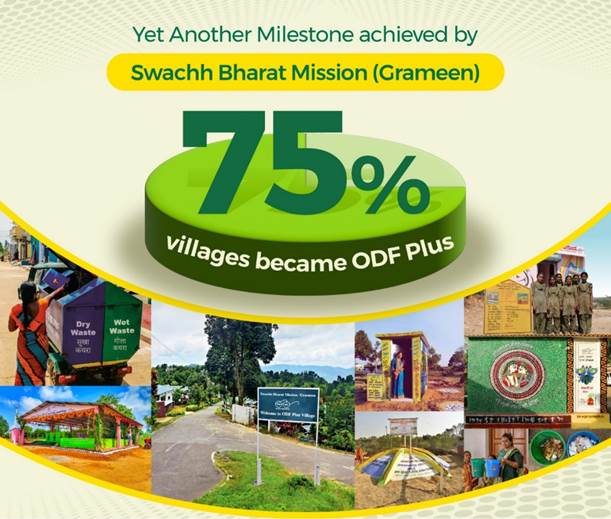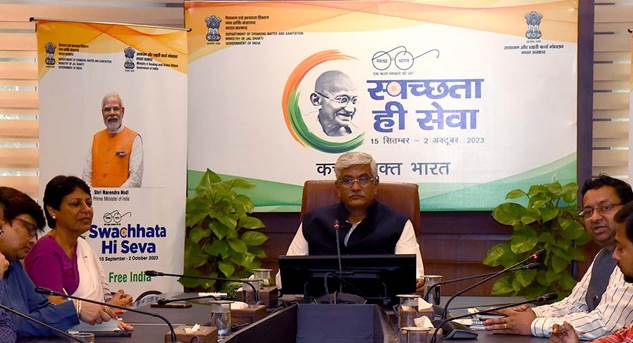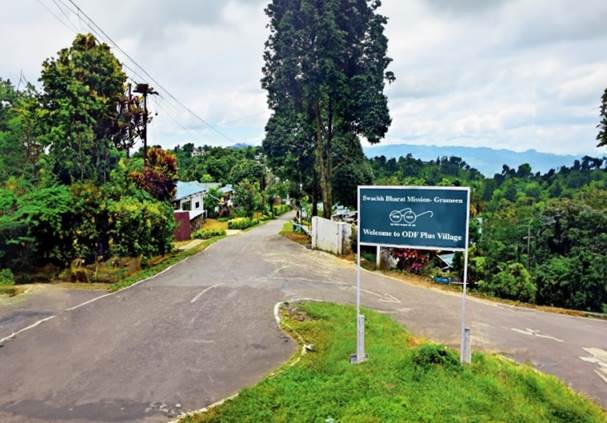India Celebrates Significant Sanitation Milestone: 75% Villages Achieve ODF Plus Status under Swachh Bharat Mission – Grameen
The country has achieved yet another major milestone under the Swachh Bharat Mission (Grameen) Phase II with three-fourth of the total villages in the country i.e., 75% villages achieving ODF Plus status under Phase II of the Mission. An ODF Plus village is one which has sustained its Open Defecation Free (ODF) status along with implementing either solid or liquid waste management systems. As on date, more than 4.43 lakh villages have declared themselves ODF Plus, which is a significant step towards achieving the SBM-G phase II goals by 2024-25.
The top performing States/UTs which have achieved 100% ODF Plus villages are – Andaman & Nicobar Islands, D&N Haveli, Goa, Gujarat, Himachal Pradesh, Jammu & Kashmir, Karnataka, Kerala, Ladakh, Puducherry, Sikkim, Tamil Nadu, Telangana, and Tripura. Among States/ UTs – Andaman & Nicobar Islands, Dadra Nagar Haveli & Daman Diu, Jammu & Kashmir and Sikkim have 100% ODF Plus Model villages. These States & UTs have shown remarkable progress in achieving the ODF Plus status, and their efforts have been instrumental in reaching this milestone.

Addressing a press conference in New Delhi today, the Union Minister of Jal Shakti, Shri Gajendra Singh Shekhawat said that Prime Minister, Shri Narendra Modi has accorded the highest priority to Swachh Bharat Mission since he took charge in 2014 and the entire nation rallied behind the call of the Prime Minister to make ‘Swachhata’ a ‘Jan Andolan’. PM’s vision and mission to make the nation Open Defecation Free by 2019 became a true mass movement and the targets were achieved well before time. PM called this achievement a stepping stone and envisioned moving towards ‘Sampoorna Swachhata’ which includes visible cleanliness and efficacious management and recycling of all waste with the vision of waste to wealth.
Shri Shekhawat further said that based on this vision and mission, SBM-G Phase-II has set the ambitious target of making all villages ODF Plus by 2025. Out of the 4,43,964 ODF Plus villages so far, 2,92,497 villages are ODF Plus Aspiring villages with arrangements for Solid Waste Management or Liquid Waste Management, 55,549 villages are ODF Plus Rising villages with arrangements for both Solid Waste Management and Liquid Waste Management and 96,018 villages are ODF Plus Model villages. Overall, so far, 2,31,080 villages have arrangements for solid waste management, and 3,76,353 villages have arrangements for liquid waste management.
The Union Minister further added that this year marks 9 years of the Swachh Bharat Mission. The achievement of 75% ODF Plus villages is a significant milestone for India, as the country has moved from ODF to ODF Plus in Swachh Bharat Mission Phase II. The major components of the Phase-II of SBM (G) are Sustaining Open Defecation Free Status (ODF-S), Solid (Bio-degradable) Waste Management, Plastic Waste Management (PWM), Liquid Waste Management (LWM), Faecal Sludge Management (FSM), GOBARdhan, Information Education and Communication/Behavior Change Communication (IEC/BCC) and Capacity Building. The SBM-G program has been instrumental in improving the health and well-being of millions of people across the country. An ODF Plus Model village is one which is sustaining its ODF status and has arrangements for both Solid Waste Management and Liquid Waste Management; and observes visual cleanliness, i.e., minimal litter, minimal stagnant wastewater, no plastic waste dump in public places; and displays ODF Plus Information, Education & Communication (IEC) messages. As on date, 96,192 villages are ODF Plus Model villages.

Shri Shekhawat stated that the entire budget outlay for SBM Phase II is 1.43 lakh crores out of which 52,497 has to come from SBM-G and the remainder has to come from 15th Finance Commission funds (51,057 cr) and MGNREGA (24,823 cr). The central share allocation from SBM-G for the year 2023-24 is Rs.7,192 Crore and the states have planned for an expenditure of 22,264 cr from all sources this year. Against this, there has been an expenditure of 4,690 cr from SBM-G funds and a total of 18,686 cr so far including FFC and MGNREGA. States with high expenditure of SBM-G funds this year are UP (1214 cr), Bihar (752 cr), and West Bengal (367 cr). These funds have been utilized to build sanitation assets, promote behavior change, and implement solid and liquid waste management systems.
The Union Minister expressed happiness that this achievement of 75% ODF Plus Villages is attained during ongoing Swachhata Hi Seva (SHS) – 2023 campaign which is being celebrated annually from 15th September to 2nd October under Swachh Bharat Mission (Grameen), Drinking Water & Sanitation Department, Ministry of Jal Shakti. He said Swachhata Hi Seva is increasing the ODF Plus momentum through Shramdaan activities with the theme of ‘Garbage Free India’, reinvigorating community participation i.e., Jan Andolan towards achieving the targets and goals of Swachh Bharat Mission.

Enumerating the major achievements of SHS-2023 so far, Shri Shekhawat informed that 5 crore people have participated in the campaign with over 2.05 crore people giving Shramdaan. Shramdaan activities include cleaning of 2,303 Beaches; 1,468 River Side and Waterfronts; 3,223 Legacy Waste Site; 480 Tourist & Iconic Spot; 32,178 Public Places; 4432 Water Bodies; 17,027 Institutional Buildings and 14,443 Garbage Venerable Sites, among other things.
Along with 34 State/ UTs in SBM-G, approx. 42 Partner Ministries/Departments are also actively participating in the SHS 2023. SBM(G) is a shining example of what can be achieved when there is a concerted and converged effort to improve sanitation and hygiene. Department of Drinking Water & Sanitation, Ministry of Jal Shakti congratulated and applauded the contribution of all villages, Gram Panchayats, Districts, States/UTs on this proud achievement.
Click Here to view SHS- 2023 State Report Card

Solid Waste Management
Plastic waste management – In terms of Plastic waste management, 2,380 Plastic Waste Management Units and 1,78,556 waste collection & segregation sheds have been set-up. Over 3 lakh vehicles are in place to ensure effective solid waste management takes place in the country. Over 2,603 blocks in the country are covered with Plastic Waste Management Units. 23 States / UTs are using waste plastic for bituminous road construction and 2 states of Tamilnadu and Kerala are using it in Cement factories. The plastic is cleaned, shredded, bailed and transported for use in road construction as per the guidelines issued by the Ministry of Road Transport & Highways and also as a fuel in cement factories etc. Approx. 1.59 lakhs gram panchayats have passed resolution to ban Single Use Plastic (SUP). The emphasis is on Urban rural convergence of plastic waste under which urban assets are effectively utilized for managing plastic waste of rural areas first, and thereafter PWMUs in rural areas are set up.
For Bio-degradable waste management at household level, people are being encouraged to segregate their dry and wet (organic) waste at source for composting at community level. 4,94,822 Community compost pits have been constructed, 1, 78,554 Waste Collection sheds are constructed, approx. 3,16,123 vehicles for collection and transportation of waste are operational as on date.
Completed 729 Biogas and 63 CBG Plants across 279 districts.
GOBARdhan, which stands for Galvanizing Organic Bio-Agro Resources-dhan, is an initiative to support biodegradable waste recovery, conversion of waste into resources and for creating clean & green village. It is a ‘waste to wealth’ initiative wherein waste generated in villages is used to generate biogas/CBG as well as bio-slurry/bio-fertilizer and is in tune with the circular economy and Mission LiFE initiatives of GoI. 848 Functional Biogas/CBG Plants have been set up across 307 districts.
Greywater Management: As per SBM(G) guidelines, it is estimated that 65-70% of potable water used at household level in rural areas gets converted to greywater which is estimated to be 36 litres per capita per day. This estimation is based on mandated supply of 55 Litres per capita of potable water as per Jal Jeevan Mission. The greywater management under SBM(G) is focused on the principle of 3Rs – Reduce, Reuse and Recharge by preferably onsite treatment strategies by sustainable and economical solutions viz., kitchen garden, soak-pit, leach-pit and magic-pit, etc. In case of bigger villages (with population more than 5000) or wherever these simple technologies are not feasible, technologies such as WSP, CW, Phytorid, DEWATs and other technologies are recommended to be adopted.
SBM(G) has taken initiatives on promotion of the effective management of greywater in rural areas by launching Sujlam Campaigns in three versions from 2021-23. The Campaigns had been able to bring about encouraging participation from every State, UT, and their respective villages. The impact was quite enormous and during the period of the three campaigns, an estimated 5.1 million soak pits were constructed for greywater management nearest to source and onsite at community areas, institutions and at drainage discharge points with minimum effort and expenses. This led to saturation of multiple villages with LWM and overall ODF Plus achievement of the States/UTs. 63% of villages have achieved greywater management and have contributed towards ODF Plus achievements. Remaining 37% of villages may achieve the same very soon. The villages with 100% Har Ghar Jal, villages under Namami Gange, Aspirational districts, SAGY and large villages with population more than 5,000 are being nudged to priotise the grey water management achievement under this 37 % leftovers . The Namami Gange villages are also prioritized by mapping and fixing the treatment systems at drainage discharge points by ensuring COD/BOD as per NGT specifications . DDWS under Greywater management is also contributing towards circularity concept by recycling grey water for irrigation purposes on small scale viz Kitchen garden and also in large scale viz Agricultural land/ Industries . DDWS is also furthering the mandate by futuristic planning and contribution towards ecosystem services .
For Faecal Sludge, Twin pit toilets are the recommended mode for in-situ treatment of liquid waste. Where there are single pit toilets, which are not yet filled up or emptied, these too are considered safe sanitation under the UNICEF and other international standards. But where they need to be emptied or where there are septic tanks (with or without soak pits), mechanized desludging and evacuating the faecal sludge to STP/FSTP for treatment becomes the mode of intervention. As on date States though SBMG IMIS have updated the toilet typology and the baseline and have reported 73% Twin Pits in total and about 12.4% Single pits and 11% Septic Tanks in the rural households. SBM(G) provides Rs 230 per capita to the States for planning either co-treatment structures or for building new FSTPs. In addition, apart from supporting Districts to strengthen mechanized desludging of on-site sanitation systems and establishing treatment units for the safe disposal of faecal sludge, there is provision of retrofitting of single pit toilets into twin pit toilets (or similar systems) for which funds from FFC/MGNREGA are to be used. The remaining toilets which have septic tanks are being linked on convergence mode with the nearest FSTP/STP. Currently. 1198 FSTPs and 765 STPs are reported functional by the States and 316 districts overall have initiated linkage with existing STPs/FSTPs under the convergence methodology. As per the data analysis of the toilet typology reported on IMIS it is observed that 288 Districts contain about 80% of the Septic tanks under the reported 11% as above and are considered as Hot Spot Districts. Of the 316 districts that have reported initiation of linkage with FSTPs/STPs abovesaid, 108 Districts are the Hot Spot Districts

